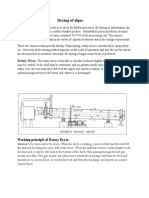Round and Rectangular Duct Structural Design
Uploaded by
kiranRound and Rectangular Duct Structural Design
Uploaded by
kiranRound and rectangular duct structural design
The structural design of ductwork plate is based on buckling of the plate element. Round
ductwork plate design is based on diameter to duct plate thickness ratios, and the allowable
stresses are contained in multiple references such as US Steel Plate, ASME/ANSI STS-
1,SMNACA, Tubular Steel Structures, and other references. In actuality round ductwork bent in
bending is approximately 30% stronger than a similar shape in compression, however one uses
the same allowable stresses in bending as we do for compression.
Round ducts require typical stiffeners at roughly 3 diameter spacing, or roughly 20 ft. O.C. for
wind ovaling and fabrication and truck shipping requirements. Round ducts, larger than 6 feet
6 inches (1.98 m) in diameter (1/4" plate) require support ring stiffeners. Smaller-diameter ducts
may not require support ring stiffeners, but may be designed with saddle supports. When
stiffener rings are required they are traditionally designed based on "Roark", although this
reference is quite conservative.
Round duct elbow allowable stresses are lower than the allowable stresses for straight duct by a
K factor = 1.65/(h 2/3power) where h = t (duct) * R (elbow) /(r(duct)*r (duct). This equation, or
similar equations is found in Tubular Steel Structures section 9.9.
Rectangular ductwork design properties is based on width-to-thickness ratios. This is simplified,
normally to width=t/16, from corner elements or corner angle stiffeners, although in reality, the
entire duct top & side plate does participate, somewhat in duct section properties.
Duct logic
Duct logic is the process of planning for duct thermal movement, combined with planning to
minimize duct dust dropout.
Ducts move with changes in internal temperature. Ducts are assumed to have the same
temperature as their internal gasses, which may be up to 900 °F. If the internal duct temperature
exceeds 1000 °F, refractory lining is used to minimize the duct surface temperature. At 1000 °F,
ducts may grow approximately 5/8 inch per 10 feet of length. This movement must be carefully
planned for, with cloth (or metal) expansion joints at each equipment flange, and one joint per
each straight section of ductwork.
Sloping ductwork at or above the duct dust angle of repose will minimize dust buildup. Therefore,
many ducts carrying high dust loads slope at 30 degrees, or steeper.
You might also like
- Technical Query Sheet Format - Heat ExchangerNo ratings yetTechnical Query Sheet Format - Heat Exchanger5 pages
- Technical Specifications For Fuel Handling PlantNo ratings yetTechnical Specifications For Fuel Handling Plant5 pages
- Design of Moment Connection Extended End Plate Moment Connection - Eight Bolts TypeNo ratings yetDesign of Moment Connection Extended End Plate Moment Connection - Eight Bolts Type2 pages
- For Hilti Anchor Design, Following Data Is RequiredNo ratings yetFor Hilti Anchor Design, Following Data Is Required2 pages
- Chapter 4. Estimation of Temperature Load Effects: E T C FNo ratings yetChapter 4. Estimation of Temperature Load Effects: E T C F7 pages
- Piping Material Specification - Tsmto 99fu M 99 Pt0 001 Rev0!3!65100% (1)Piping Material Specification - Tsmto 99fu M 99 Pt0 001 Rev0!3!6564 pages
- Pressure Vessels: Horizontal On Two Saddles - DesignNo ratings yetPressure Vessels: Horizontal On Two Saddles - Design20 pages
- Material Handling Systehls For THE Fluidized-Bed Combustion Boiler Rivesville, J. Rranam Rosborough The MITRE CcrporationNo ratings yetMaterial Handling Systehls For THE Fluidized-Bed Combustion Boiler Rivesville, J. Rranam Rosborough The MITRE Ccrporation20 pages
- Types of Fans in Thermal Power Plant: Sanjay Gupta Manager (Mech)No ratings yetTypes of Fans in Thermal Power Plant: Sanjay Gupta Manager (Mech)25 pages
- Rashtriya Ispat Nigam Limited, Visakhapatnam Steel Plant: Dy General Manager - Works Contracts I/cNo ratings yetRashtriya Ispat Nigam Limited, Visakhapatnam Steel Plant: Dy General Manager - Works Contracts I/c9 pages
- Checklist For Economiser Element DrawingNo ratings yetChecklist For Economiser Element Drawing2 pages
- Sizing Calculation of Dry Electro-Static Precipitator (DESP)No ratings yetSizing Calculation of Dry Electro-Static Precipitator (DESP)12 pages
- Plate Fabricated Pipe Calculation Sample PDFNo ratings yetPlate Fabricated Pipe Calculation Sample PDF4 pages
- Feed Gas Pre-Heater Efficiency Calculation and Enhancement of Ammonia PlantNo ratings yetFeed Gas Pre-Heater Efficiency Calculation and Enhancement of Ammonia Plant10 pages
- Design Theory of Circulating Fluidized Bed Boilers: KeywordsNo ratings yetDesign Theory of Circulating Fluidized Bed Boilers: Keywords15 pages
- Alloy C Torispherical Dished End CalculationNo ratings yetAlloy C Torispherical Dished End Calculation7 pages
- Calculation of Power Pumps On Otec Power Plant Ocean (Ocean Thermal Energy Conversion)No ratings yetCalculation of Power Pumps On Otec Power Plant Ocean (Ocean Thermal Energy Conversion)14 pages
- Boiler: Sabari Girish N Sr. Engineer (O)No ratings yetBoiler: Sabari Girish N Sr. Engineer (O)37 pages
- From Wikipedia, The Free Encyclopedia: Process Duct WorkNo ratings yetFrom Wikipedia, The Free Encyclopedia: Process Duct Work17 pages
- Shell and Tube Heat Exchanger Design PreparedNo ratings yetShell and Tube Heat Exchanger Design Prepared6 pages



























































